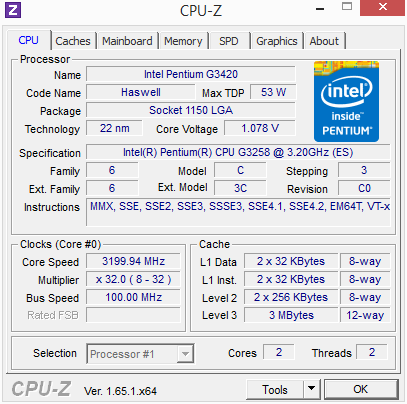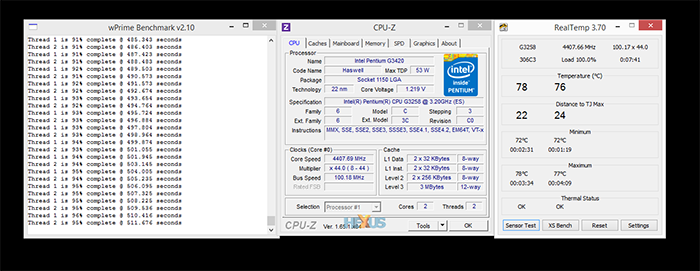Testing Methodology
Intel Pentium AE G3258 Specification |
|---|
 |
Comparison Processor Configurations |
||||||||||
|---|---|---|---|---|---|---|---|---|---|---|
| CPU | Intel |
AMD |
||||||||
Pentium G3220 |
Pentium G3258 |
Core i3-4330 |
Core i5-4670 |
Core i7-4770K |
Athlon 5350 |
A8-7600K |
A10-7850K |
A8-6500T |
A10-6800K |
|
| CPU TDP | 53W |
53W |
54W |
84W |
84W |
25W |
65W/45W |
95W |
65W |
100W |
| Socket | LGA 1150 |
LGA 1150 |
LGA 1150 |
LGA 1150 |
LGA 1150 |
AM1 |
FM2+ |
FM2+ |
FM2 |
FM2 |
| Fabrication | 22nm |
22nm |
22nm |
22nm |
22nm |
28nm |
28nm |
28nm |
32nm |
32nm |
| Motherboard | Gigabyte GA-Z87M-D3H |
Asus Z97-A |
Gigabyte GA-Z87-D3HP |
Asus Z97-A |
ASRock AM1B-ITX+ |
ASRock FM2A88X-ITX+ |
||||
| BIOS | F9 |
1008 |
F5 |
1008 |
1.0 |
1.90 |
||||
| DDR3 Memory | Corsair XMS3 8GB (2x4GB) |
Corsair XMS3 8GB (2x4GB) |
AMD Gamer Series 16GB (2x8GB) |
AMD Gamer Series 4GB (1x4GB) |
AMD Gamer Series 16GB (2x8GB) |
|||||
| Memory Timings | 9-9-9-24-2T @ 1,600MHz |
9-10-9-27-2T @ 1,866MHz |
9-9-9-28-2T @ 1,600MHz |
10-11-11-28-2T @ 2,133MHz |
9-10-9-27-2T @ 1,600MHz |
10-11-11-28-2T @ 2,133MHz |
||||
| Integrated Graphics | HD Graphics |
HD Graphics |
HD 4600 |
HD 4600 |
HD 4600 |
Radeon R3 |
Radeon R7 |
Radeon R7 |
HD 8550D |
HD 8670D |
| Disk Drive | Crucial M500 240GB |
Samsung 840 Pro 250GB |
||||||||
| Power Supply | Corsair VS450 (450W) |
Corsair AX760i (760W) |
||||||||
| Operating System | Windows 8.1 64-bit |
|||||||||
CPU and Memory Benchmarks |
||||||||||
| HEXUS PiFast | Our number-crunching benchmark stresses a single core by calculating Pi to 10m places | |||||||||
| CineBench R15 | Using Cinebench's multi-CPU render, this cross-platform benchmark stresses all cores | |||||||||
| wPrime 2.1.0 | Another number-crunching benchmark that stresses all available CPU cores/threads | |||||||||
| AIDA64 v4.00.2746 | Benchmark that analyses memory bandwidth and latency | |||||||||
Multimedia Benchmarks |
||||||||||
| LuxMark 2.0 | An OpenCL rendering benchmark | |||||||||
| MuseMage 1.9.6 | An OpenCL image-manipulation benchmark (64-bit) | |||||||||
| HandBrake 0.9.9.1 | Free-to-use video encoder that stresses all CPU cores (64-bit) | |||||||||
System Benchmarks |
||||||||||
| PCMark 8 v2.0 | System-wide examination that uses the Home preset, run with OpenCL acceleration | |||||||||
| 3DMark | DX11, run at the Fire Strike default test | |||||||||
| SiSoft Sandra 2014 | Aggregate score that takes a composite of 12 system-wide benchmarks | |||||||||
Gaming Benchmarks |
||||||||||
| BioShock Infinite | DX9, 1,280x720, medium quality | |||||||||
| GRID 2 | DX9, 1,280x720, high quality | |||||||||
| Total War: Rome II | DX9, 1,280x720, medium quality | |||||||||
Miscellaneous Benchmarks |
||||||||||
| Power Consumption | While idling and when running wPrime and GRID 2 | |||||||||
Notes
We've run the engineering-sample processor, provided by Intel, at the default 3.2GHz. Obtaining these numbers provides a frame for reference once we overclock it. Using the stock heatsink and dialling voltage up to 1.20V (from 1.10V) we managed to increase the base multiplier to 44x, or a final, stable speed of 4,400MHz.
4.5GHz was semi-stable, falling over very occasionally, and it would likely be stable with a beefier cooler on top. We also increased the graphics frequency from 1.1GHz to 1.4GHz, thus making the most of the unlocked nature of the chip. The ensuing benchmarks have both Pentium Anniversary Edition configurations - stock and overclocked - in the graphs.










